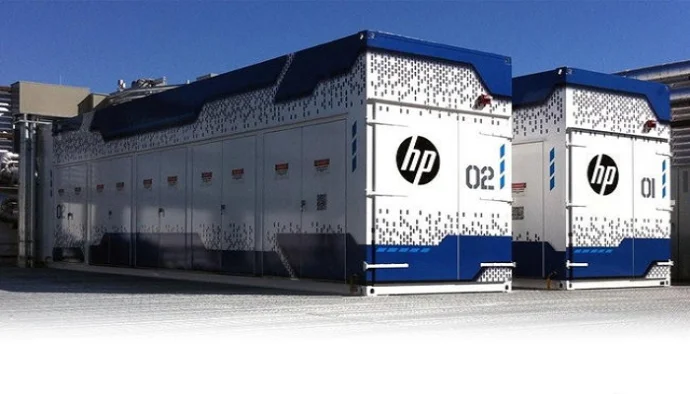The Rise of Modular and Containerised Datacentres
The idea of using a shipping container to house a datacentre may not convey the same image as a ‘bricks and mortar’ building but is a very practical alternative. Prefabricated containers are the infrastructure backbone of many leading hyperscale cloud-serving organisations so why would you not consider this for your own on-site datacentre facility?
The definition of a datacentre is a secure and managed environment and one of the nearest examples to where we are based is UKFast (https://www.ukfast.co.uk/) in Manchester, UK. This is a Tier-3 colocation datacentre offering a range of hosting and datacentre services. It is a ‘bricks and mortar’ building but one more advanced than many in terms of the working environment it provides for its employees. The building and its fitout are part of the organisational culture and the company offers an outstanding environment in which to work.
Being based on outskirts of Manchester means that space is limited for expansion. So the only alternatives we can see for the organisation would be to either purchase more land for additional datacentre facilities onto which to build more traditional buildings or to go down the containerised datacentre (also known as the modular datacentre) route.
This is the dilemma faced by many server room and datacentre operators today. When you run out of space within your facility or want to rapidly scale out a standardised datacentre design and configuration, how best can you do it? In two words: prefabricated containers.
The Challenges When Building Datacentres
Aside from provide a secure and managed environment for IT servers, datacentre operators face several challenges at the outset of a refurbishment or new build project. Technology continues to develop at a rapid pace, and we are seeing this now within innovations such as the latest 5G wireless network, Edge Computing and Internet of Things (IoT). All with great promise in terms of greater connectivity and more rapid service provision.
Geography is also important. Where can you get land at a reasonable price with planning permission for a new building. How secure is the area and what are the environmental concerns that must be addressed in terms of local site constraints i.e. noise and access, local employee pool and services? Other location-based considerations include power and fibre availability and their resilience, as well as local weather patterns and climate.
Scalability and flexibility are also of concern. Datacentre technologies change within a 3-5 year a period and the overall life expectancy of the critical infrastructure must be sufficiently flexible to keep pace with the developments. Then there is the actual cost and construction times required for a traditional building.
Prefabricated buildings provide the answer. These can be purpose-built and portable buildings based on ISO 20 or 40foot shipping containers or bespoke metal cabins.
Modular Datacentres for Military and Emergency Deployments
Containerised or modular data datacentres originate from around the late 1990s and they were originally perceived as a disaster recovery (DR) solution that could be quickly deployed following a site disaster. Several of the leading IT industry companies including HP, IBM and SUN offered lorry based containerised datacentres for rapid deployment if a datacentre needed an emergency facility due to a fire, catastrophic failure or even additional short-term server capacity.
The containerised solution was also seen by the military to quickly ‘drop’ a functional datacentre into a remote location, whether as part of a peace keeping exercise or theatre of war.
When the original datacentre was back up and running or the military support or operation over, the containerised datacentre could be placed back onto a lorry and transported to another area or airport or port for air or sea shipment.
Commercial and Public Sector Datacentre Operations
Some commercial hyperscale datacentre operators have adopted the modular data centre as part of their rapid growth strategies. Google and Amazon AWS are clear examples of this. Using prefabricated containers, systems and components these companies can save time and money over a more traditional building-based datacentre.
The container houses the same types of critical infrastructure systems whether its LV switchgear and UPS for power protection or cooling, server racks, fire suppression and IT connectivity. The containerised approach ensures the roll out of a standardised design.
Public sector organisations can also benefit from the containerised approach. Hospitals for example can ‘hook-up’ a containerised solution to their existing on-site server room or datacentre facilities. This can be a temporary arrangement or a permanent one. Both the traditional and modular building provide a managed and secure server environment, with the additional containerised building being made available quicker and at a fraction of the cost of the current building.
The Advantages of a Modular Datacentre
Many components and systems within a datacentre are now modular. UPS and cooling systems are typical examples. The approach improves service and preventative maintenance times and is more easily scalable than traditional ‘fixed’ designs. These same advantages roll-up for containerised and modular datacentres facilities.
- Easily scalable using a standardised component approach
- Transportable and mobile and can be delivered to any prepared concrete plinth
- Rapid build-out and deployment with horizontal and even vertical growth potential
- Use existing land already owned by the facility operator with a planning permit
- Offer as high an energy efficiency PUE metric as a traditional building
- Can offer higher security through bomb and earthquake protection
- Fast to connect, commission and make operational
- Provide IT independent critical infrastructure
A well specified and designed modular datacentre is not only easily scalable. It should also be independent of the IT to be used over its working life. This places some emphasis on the future power and cooling demands but means that the modular building can support any range of IT server from commercially available high-performance computing servers to supercomputers required for advanced computing and artificial intelligence applications.
Summary
The market for containerised and modular datacentres is growing at a rapid rate and there are a range of standardised offerings. The concept is one that has gone from being a DR and emergency deployment option to the principle design choice for several types of commercial and public sector operators.
Several critical infrastructure manufacturers now offer modular designs using a combination of their own systems and some sourced components. Eaton, Schneider and Vertiv are good examples of this as UPS, cooling solution and rack companies using modular and containerised solutions as an extension to their product sets.
Bespoke designs are also available from providers such as Server Room Environments who can project manage an entire modular or containerised datacentre facility from its initial design and fit-out to onsite delivery, installation, commissioning and ongoing maintenance. Our supply chain includes the principle system global manufacturers mentioned above for UPS, cooling and racks and more local metalwork fabrication and container fit-out specialists ensuring we can deliver a fully ‘on-spec’ solution.

























